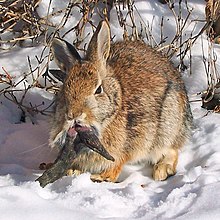Shope papillomavirus
| Shope papilloma virus | |
|---|---|
 |
|
| Rabbit with Shope papillomavirus infection | |
| Virus classification | |
| Group: | Group I (dsDNA) |
| Family: | Papillomaviridae |
| Genus: | Kappapapillomavirus |
| Species: | Kappapapillomavirus 2 |
| Synonyms | |
|
|
The Shope papilloma virus (SPV), also known as cottontail rabbit papilloma virus (CRPV) or Kappapapillomavirus 2, is a papillomavirus which infects certain leporids, causing keratinous carcinomas resembling horns, typically on or near the animal’s head. The carcinomas can metastasize or become large enough to interfere with the host’s ability to eat, causing starvation. Richard E. Shope investigated the horns and discovered the virus in 1933, an important breakthrough in the study of papillomaviruses and neoplasia. The virus was originally discovered in cottontail rabbits in the Midwestern U.S., but can also infect brush rabbits, black-tailed jackrabbits, snowshoe hares, and European rabbits (Praag et al. 2003).
In the 1930s, hunters in northwestern Iowa reported that the rabbits they shot had several "horn" protrusions on many parts of their bodies including their faces and necks (Shope et al. 1933). The virus is also a possible source of myths about the jackalope, a rabbit with the horns of an antelope, and related cryptids such as the wolpertinger. Stories and illustrations of horned rabbits appear in scientific treatises dating back many years, such as the Tableau encyclopédique et méthodique, from 1789.
The Iowa reports led cancer researcher Richard E. Shope to investigate, and he discovered the virus in 1933 (Kreider et al. 1981). He separated the virus from horny warts on cottontail rabbits, and made one of the first mammaliam tumor virus discoveries (Kreider et al. 1981). Shope determined the protrusions were keratinous carcinomas due to the infection of CRPV. Shope's research led to the development of the first mammalian model of a cancer caused by a virus. He was able to isolate virus particles from tumors on captured animals and use these to inoculate domestic rabbits, which then developed similar tumors. This has contributed to our understanding of fundamental mechanisms in neoplasia, or the formation of a new, abnormal growth of tissue (Kreider et al. 1981). The virus was sequenced in 1984, showing substantial sequence similarities to HPV1a. It has been used as a model for human papillomaviruses both before and after this discovery. The most visible example of this role is the HPV vaccine, which was developed based on and incorporating research done using the virus as a model. Similarly, it has been used to investigate antiviral therapies.
...
Wikipedia
